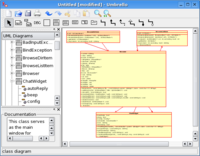Computer-aided software engineering

Have you ever drawn a picture or made a craft with special tools like scissors, glue, and a ruler to help you make it just right? Well, computer-aided software engineering is kind of like that, but for people who make computer programs instead of crafts.
Computer-aided software engineering (CASE) is a fancy way of saying that people use special computer programs to help them build better computer programs. Just like you might use a ruler to make sure your lines are straight in a drawing, computer engineers use CASE tools to help them make sure the computer program they are designing has all the right parts and works the way it's supposed to.
One of the very cool things about CASE tools is that they can help people work together to make a computer program. Let's say that four people are working on the same computer program, but they are all working on different parts of it. They could each make their own version of the program, but then they would have to try and put all four versions together to make one working program. That wouldn't be a very good use of time!
Instead, they can use CASE tools that help them all work on the same program at the same time. Think of it like each person having their own piece of the puzzle that they are working on, but with a special tool that shows them where their piece fits in with everyone else's pieces.
CASE tools also make it easier for computer engineers to see how the program will work before they actually make it. This is called "simulation" and it means that computer engineers can pretend to run the program and see what might happen if someone were to use it. This can help them find problems or mistakes before anyone else uses the program.
In short, computer-aided software engineering tools are computer programs that help people make better computer programs by letting them work together more easily and see what their program will do before they actually make it.
Computer-aided software engineering (CASE) is a fancy way of saying that people use special computer programs to help them build better computer programs. Just like you might use a ruler to make sure your lines are straight in a drawing, computer engineers use CASE tools to help them make sure the computer program they are designing has all the right parts and works the way it's supposed to.
One of the very cool things about CASE tools is that they can help people work together to make a computer program. Let's say that four people are working on the same computer program, but they are all working on different parts of it. They could each make their own version of the program, but then they would have to try and put all four versions together to make one working program. That wouldn't be a very good use of time!
Instead, they can use CASE tools that help them all work on the same program at the same time. Think of it like each person having their own piece of the puzzle that they are working on, but with a special tool that shows them where their piece fits in with everyone else's pieces.
CASE tools also make it easier for computer engineers to see how the program will work before they actually make it. This is called "simulation" and it means that computer engineers can pretend to run the program and see what might happen if someone were to use it. This can help them find problems or mistakes before anyone else uses the program.
In short, computer-aided software engineering tools are computer programs that help people make better computer programs by letting them work together more easily and see what their program will do before they actually make it.
Related topics others have asked about:
